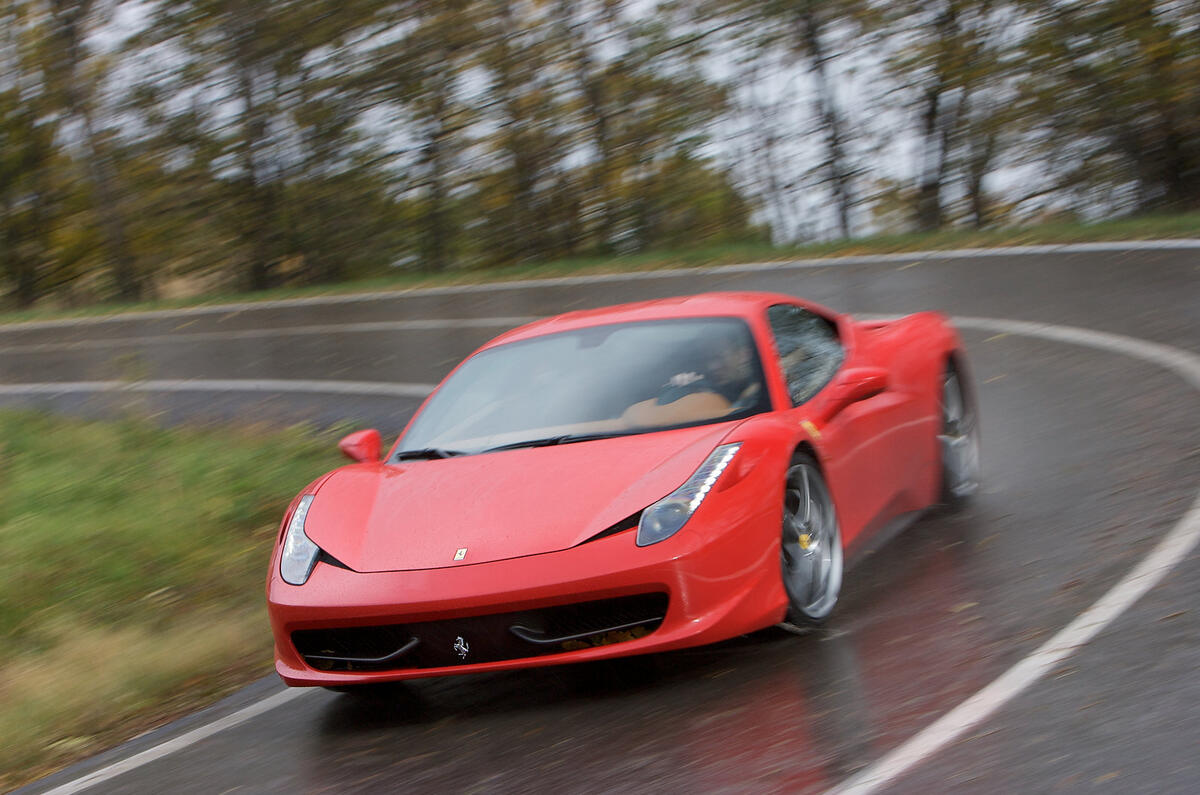What is it?
The 458 Italia is the replacement for the F430. Although the basic configuration sticks to established principles i.e an aluminium space-frame and mid mounted V8 powering the rear wheels, much of the 458 is entirely new.
For starters, the engine is a 4.5-litre direct injection V8, related to that in California, but larger, producing much more power (562bhp) and revving higher (9000rpm).
And like the California the power is channeled to the road through a seven-speed twin-clutch gearbox, albeit with different ratios.
What’s it like?
At first relatively civilised, the idle smooth and calm. It’ll get you noticed, but it’s no hell raiser. However, like most modern performance cars, the 458 has trick exhaust by-pass flaps, so there’s a good chance with revs and throttle it will be more boisterous.
Metres is all it takes to register the first significant dynamic step change over the 458’s predecessor. The steering is much quicker. 2.0 turns lock to lock quick, and that considering a very reasonable turning circle.
The next thought, is how well the gearbox works, especially in the very ordinary roll of manoeuvring the 458 in traffic. Up in the hills though, I’m keen to explore whether a twin-clutch gearbox can deliver the sense of occasion and drama expected of a 200mph+ Ferrari.
To an extent it is a personal choice, and depends on whether you feel the jolt you get with a super-fast single clutch transmission - such as that fitted to the 430 Scuderia - to be a highlight or deficiency. Certainly the 458’s DCT is much smoother and faster than the F1 box, and yet, in my opinion, feels no less mechanical.
The gearbox is also well matched to the engine character, not only in its speed of reaction, but also its exactness. To get a handle on how much quicker the 458 is than the F430 you need to look not only at the jump in outright power (70bhp), but also where the power (and torque) is produced.
From 3500rpm the 458’s engine is already producing as much torque as the F430’s and at 6500rpm has eclipsed its peak power. This is a Ferrari V8 even more zingy and soulful than before, but now with added mid-range punch. To boot, it’s cleaner and leaner than the old 4.3.
Over the last 2000rpm, the energy and vigour is massively addictive. As is the noise. Any concerns over the timid idle have long since vanished, the 458 soundtrack not only ridiculously loud, but varied and with that shrillness only a flat crank Ferrari V8 can.
If there is a downside, it is that that on the road there are precious few opportunities to use all 458’s performance. Even in Italy. If you’re lucky you’ll see all of second gear, and occasionally third, but, such is the extent of the rev range and force of 562bhp, by then you’re really travelling.
More so than the styling, or engine performance, the one component that describes the biggest advance over the old car, is the confidence you get in 458’s front end. And this not simply a matter of more outright grip, but more consistency and better communication.
Apparently this transformation comes mostly from improvements in the rear multi-link suspension. By better controlling the camber angle and wheel centre movement, Ferrari has been able to increase roll stiffness and run faster more precise steering. And what of that quicker steering?



















































Join the debate
Add your comment
Re: Ferrari 458 Italia
Hi everybody. My name is Bruno Prata, I'm 28 years old and I live in Castelo Branco, Portugal. I'd like to tell all of you that I am a big fan of cars. The Ferrari 458 Italia was unveiled to the world at the 2009 IAA Motor Show in Frankfurt, Germany, as a replacement for the old F430 and two years later it was unveiled the convertible version of the 458 Italia, the 458 Spider, but with a power retractable hard-top.
This car (the Ferrari 458 Italia) represents a genuine break with the past in terms of Maranello's previous high-performance sports cars. Designed to fulfil the expectations and ambitions of most passionate clients, the 458 continues Ferrari's tradition of putting the thrill into driving as a result of track-derived technological innovations.
Thanks to a 4.5 litre V8 engine with direct fuel injection, which punches out a maximum power output of 570 bhp, the 7-speed twin-clutch gearbox and a 1380 kg dry weight, this car boasts an extraordinary weight-power ratio of 2.42 kg/hp (a power-weight ratio of 413 hp per ton). This means it sprints from 0 to 100 Km/h (0-62 mph) in less than 3.4 seconds and hits a top speed of over 325 Km/h.
The 458 delivers superb vehicle dynamics with an ideal weight balance for a mid-rear engined sports car - 58 percent at the rear, 42 percent at the front. Evolved electronic control systems also help guarantee maximum performance in all driving conditions. Its new suspension set-up, featuring double wishbones with L arms at the front and a multilink set-up at the rear, is tuned for ultimate road-holding and superlative handling. This, together with a more direct steering ratio, ensures the car is extremely responsive whilst maintaining superior ride comfort.
As is the case with Scuderia Ferrari Formula 1 single-seaters, Ferrari engineers has focused their efforts on achieving maximum efficiency right across the board with this car. The result is that the 458 produces only 307 g/km of CO2 and has a fuel comsumption of just 13.3 l/100 Km (combined cycle), a benchmark for the entire segment.
Aside from the work done to reduce both internal friction in the engine and overall weight, this result has been achieved thanks to aerodynamic research which focused on cutting drag and maximising downforce.
The 458 is thus a syntesis of technological innovation, creative flair, style and passion, a combination of characteristics for which Italy as a nation is renowned. Ferrari's President, Luca di Montezemolo, chose to pay homage to this fact by adding the name of the car's homeland to the traditional figure representing the displacement and number of cylinders.
The front nose of the 458 features a single opening for the front grille and side air intakes, with aerodynamic sections and profiles designed to direct air into the coolant radiators and the flat underbody. It also sports two small aeroelastic winglets which generate downforce and, at high speed, they deform to reduce the section of the radiator intake and also reduce drag.
The engine is a dry-sump 90 degree V8 with a total displacent of 4499 cc and is mid-rear mounted. It is an entirely new design engineered to reach a maximum rev range of 9000 rpm - a first on a road car - with a high 12.5:1 compression ratio and a maximum power output of 570 bhp, but is also a true masterpiece. This equates to an outstanding specific power output of 127 hp/litre, a benchmark for a naturally-aspirated production engine.
The generous torque available - 540 Nm at 6000 rpm, with over 80 percent available from 3250 rpm - ensures quick pick-up from all revs. The specific torque output of 120 Nm/l is another record.
The design of the engine components has been influenced by the carry-over of racing technology - F1 in particular - for maximum fluid-dynamic efficiency in order to achieve both performance and fuel comsumption objectives, and also meet the most stringent international emissions restrictions. The piston compression height was reduced as per racing engine practice. Similarly, thinner compression rings have been adopted to minimise friction between piston and liner. A graphite coating was applied to the piston skirt for the same reason.
To help further reduce internal friction, the cylinder block has four scavenge pumps. Two of them pick up oil from the cylinder heads and front and rear of the engine via dedicated oil recovery ducts outside the crankcase area, and other two pick up oil from below the crank throws. The recovery ducts of the latter are interconnected in two groups of four cylinders to optimise the scavenge function and create a strong vacuum (800 mbar) around the crankshaft. This solution prevents excess oil splashing out of the sump and onto the rotating losses due to windage caused by the pumping action of the pistons.
The engine oil pressure pump features variable displacement geometry which reduces the amount of power absorbed at high revs. Lowering the pump's displacement actually increases the power available at the crankshaft for the same amount of fuel used.
As is traditional for Ferrari engines, the new V8 is equipped with continuosly variable valve timing on both inlet and exhaust cams. The aluminium intake manifold has been lightened by reducing the wall thickness. It has short, almost straight inlet tracts to reduce losses and a system that varies the geometry of the manifold, optimising the volumetric efficiency throughout the rev range. This is achieved by incorporating three pneumatic throttle valves in the central section between the two plenums. The engine mapping provides four different configurations of the valves for optimum torque values at all revs.
The use of direct fuel injection with Split Injection improves engine performance by modulating the injection in two phases, increasing combustion efficiency and the torque at low revs (by up to 5 percent). A high injection pressure (200 bar) guarantees adequate pulverisation of the fuel and an optimal air/fuel mixture right up to 9000 rpm. This feature again results in better performance and also lower fuel comsumption.
The exhaust system was designed to provide the kind of thrilling soundtrack owners of Ferrari's V8s are used to whilst also guaranteeing high levels of acoustic comfort. One of the main objectives with the exhaust was to reduce weight. The catalytic converter is attached to the central section of the exhaust by a flexible element to reduce the amount vibration transmitted and to thus allow thinner metal to be used. Similarly the pre-catalytic converter has been eliminated, lowering overall weight and reducing back pressure whilst still respecting strict Euro 5 and LEV2 emissions.
One of the important novelties on the 458 Italia was the introduction of the 7-speed twin-clutch gearbox which guarantees faster yet smoother gear changes. The technology is based on the independent management of even and odd gears which are pre-selected using two separate input shafts. The gear shifting time (the overlap between the opening and closing phases of the two clutches) is zero and thus there is no interruption of engine torque to the rear wheels. Compared with the Ferrari California gearbox, response times have been reduced and the 458 Italia has specific, sportier gear ratios to match the power and torque curves of the V8, guaranteeing high torque even at lower revs. The E-Diff 3 electronic differential has also been integrated into the gearbox, resulting in a more compact and lighter unit.
Re: Ferrari 458 Italia
Yes, a very bizarre first post.
Re: Ferrari 458 Italia